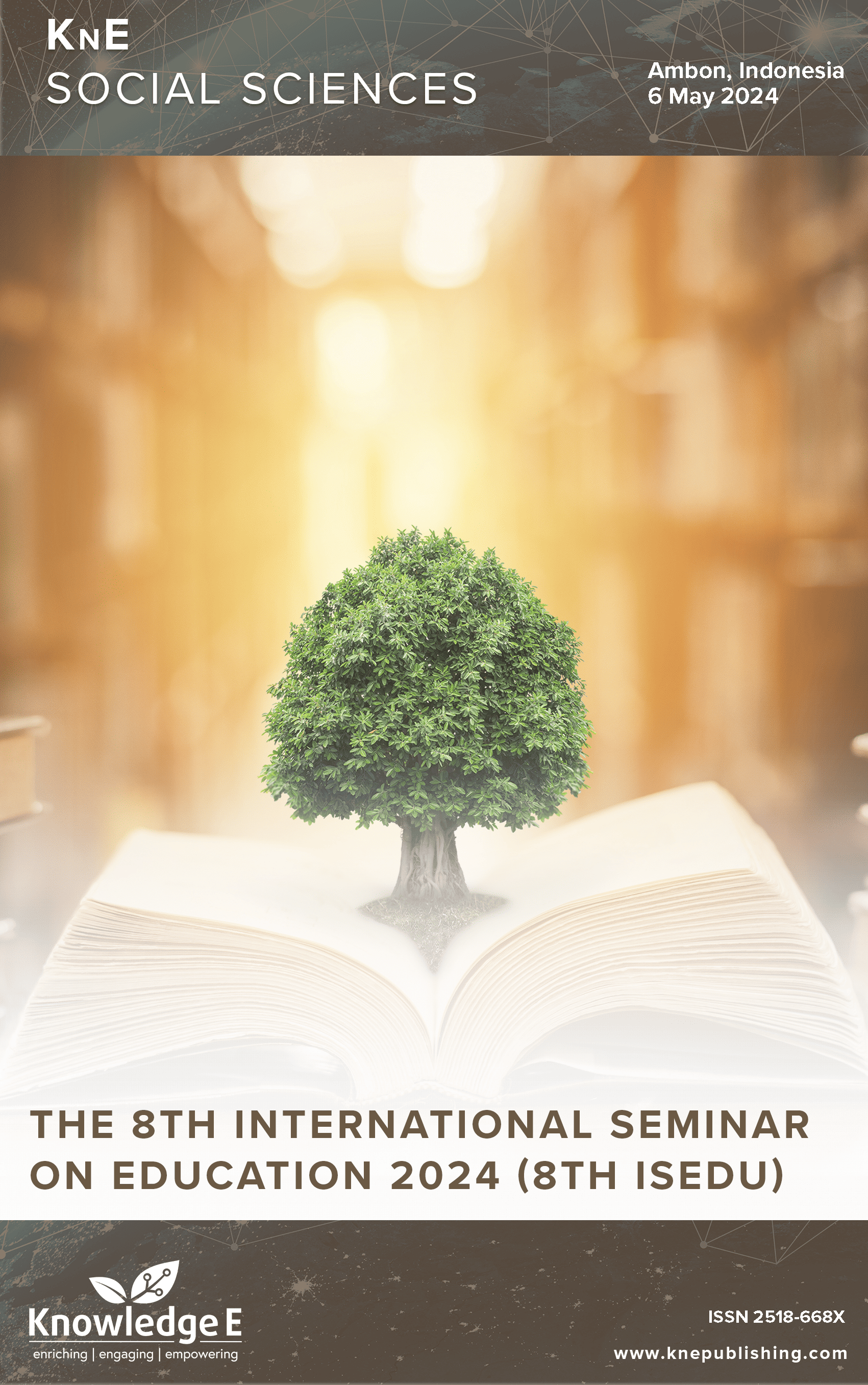Creating an Environment that Influences Children's Learning and Character Qualities
DOI:
https://doi.org/10.18502/kss.v9i31.17590Abstract
This study aimed to describe the environment created by parents for their children and its effects on academic performance and character qualities. Utilizing a survey methodology, data were collected through direct and indirect observations and analyzed qualitatively. The research subjects comprised two children from the same family. The findings revealed that the parents created an environment to engage the children in arts and physical exercise. They provided various tools such as musical instruments, laptops, smartphones, bikes, paper and coloring pencils, building blocks, toys, puzzles, and books to facilitate activities like singing, playing, reading, typing, writing, and creating. Although the language setting of these tools was in English, parents communicated with the children in Indonesian. The effects of this environment were evident in the children’s development of characteristics such as resilience, creativity, responsibility, and self-regulated learning. These traits, fostered by the environment, subsequently contributed to the children’s enjoyment and success in academic, social, language, and artistic performances.
Keywords: creating environment, children learning, character qualities
References
Hardin CJ. Effective classroom management: Models and strategies for today’s classrooms. Pearson; 2004.
Jones VF, Jones LS. Comprehensive classroom management: Creating communities of support and solving problems. 12th ed. Pearson; 2021.
Feist J, Feist GJ. Theories of personality (7th edition). McGraw-Hill Primis, 2008.
Schultz DP, Schultz SE. Theories of personality (8th Edition (Ed.)). Wadsworth, Cengage Learning. 2005.
Woodward S. Ronald mace and his impact on universal design. The Center for Disability Rights. 2023. https://shorturl.at/aj579
The RL Mace Universal Design Institute. The principles. The R.L Mace Universal Design Institute; 2019. https://doi.org/10.4324/9780080557601. DOI: https://doi.org/10.4324/9780080557601
Carrington S, Saggers B, Webster A, Harper-Hill K, Nickerson J. What universal design for learning principles, guidelines, and checkpoints are evident in educators’ descriptions of their practice when supporting students on the autism spectrum? Int J Educ Res. 2020;102(April):101583. DOI: https://doi.org/10.1016/j.ijer.2020.101583
CAST. Universal design for learning guidelines version 2.2. 2018. /https://udlguidelines.cast.org/
Ahmed SP, Bittencourt-Hewitt A, Sebastian CL. Neurocognitive bases of emotion regulation development in adolescence. In Developmental cognitive neuroscience (Vol. 15), 2015. https://doi.org/10.1016/j.dcn.2015.07.006 DOI: https://doi.org/10.1016/j.dcn.2015.07.006
Cortázar C, Nussbaum M, Harcha J, Alvares D, López F, Go ni J, et al. Promoting critical thinking in an online, project-based course. Comput Human Behav. 2021 Jun;119(February):106705. DOI: https://doi.org/10.1016/j.chb.2021.106705
Hitipeuw I. Belajar dan Pembelajaran. Fakultas Ilmu Pendidikan Universitas Negeri Malang. 2009. https://shorturl.at/bhnuF
Kurki K, Järvelä S, Mykkänen A, Määttä E. Investigating children’s emotion regulation in socio-emotionally challenging classroom situations. Early Child Dev Care. 2015;185(8):1238–54. DOI: https://doi.org/10.1080/03004430.2014.988710
Levin J, Nolan JF. Principles of classroom management: A professional decisionmaking model. 7th ed. Pearson; 2014.
Ryan RM, Deci EL. Intrinsic and extrinsic motivation from a self-determination theory perspective: Definitions, theory, practices, and future directions. Contemp Educ Psychol. 2020;61:101860. DOI: https://doi.org/10.1016/j.cedpsych.2020.101860
Muallifah PM, Hitipeuw I, Sudjiono. The influence of academic motivation and parental involvement on student engagement. Int J Human Appl Soc Sci. 2018;3(11), 48–59. https://ijhassnet.com/news-details.php?id=55
Mayer RE. Cognitive theory of multimedia learning. In: Mayer RE (Ed). The Cambridge handbook of multimedia learning. 2nd ed. Cambridge University Press; 2014. pp. 43–71. DOI: https://doi.org/10.1017/CBO9781139547369.005
Wood E, Willoughby T. Children’s learning in a digital world. In Children’s learning in a Digital World. 2008. pp. 299–301. https://doi.org/10.1002/9780470696682.oth1 DOI: https://doi.org/10.1002/9780470696682.oth1
Board of Education Wayne. Examples of curriculum-based measurement probes: Field guide to RtI. Wayne County RtI/LD Committee. 2007. https://shorturl.at/xKT19
Vanderheyden AM, Snyder PA, Broussard C, Ramsdell K. Measuring response to early literacy intervention with preschoolers at risk. Topics Early Child Spec Educ. 2008;27(4):232–49. DOI: https://doi.org/10.1177/0271121407311240
Wanzek J, Vaughn S, Scammacca N, Gatlin B, Walker MA, Capin P. Meta-analyses of the effects of Tier 2 type reading interventions in Grades K-3. Educ Psychol Rev. 2016 Sep;28(3):551–76. DOI: https://doi.org/10.1007/s10648-015-9321-7
Hitipeuw I, Sadijah C, Hastuti W. Helping school to overcome at risk students: Some experiences. In Ulfa S, Sunaryono, Tauqif A, Wibawa AP (Eds). Proceedings of the 2nd International Conference on Learning Innovation (ICLI 2018) (pp. 246–250). SCITEPRESS. 2019. https://doi.org/DOI: https://doi.org/10.5220/0008410602460250. DOI: https://doi.org/10.5220/0008410602460250
Kilgus SP, Riley-Tillman TC, Chafouleas SM, Christ TJ, Welsh ME. Direct behavior rating as a school-based behavior universal screener: Replication across sites. J Sch Psychol. 2014 Feb;52(1):63–82. DOI: https://doi.org/10.1016/j.jsp.2013.11.002
Jonathan. Prof. Yohanes Surya PhD – Tolong Carikan Saya Anak yang Paling Bodoh dari Papua. 2017. Maxmanroe.Com. https://www.maxmanroe.com/yohanessurya. html
Khaerunisa. (2021, September). Sanggup Bawa Bocah-bocah Pedalaman Papua Borong Medali di Olimpiade Sains Internasional, Inilah Kisah Yohanes Surya, Profesor yang Buktikan Bahwa “Tidak Ada Anak yang Bodoh.” Intisari Online. https://shorturl.at/hmty0
Sousa DA. How the brain learns. 5th ed. Corwin; 2017. https://doi.org/10.4135/9781071855324. DOI: https://doi.org/10.4135/9781071855324
Brown RD, Bjorklund DF. The biologizing of cognition, development, and education: Approach with cautious enthusiasm. Educ Psychol Rev. 1998;10(3):355–73. DOI: https://doi.org/10.1023/A:1022149913184
Miltenberger RG. Behavior modification: Principles and procedures (2nd ed.). In Behavior modification: Principles and procedures (2nd ed.). 2012. https://doi.org/10.1080/01431161.2016.1204478 DOI: https://doi.org/10.1080/01431161.2016.1204478
Woolfolk A. Educational psychology, Thirteen Edition. In Pearson Education Ltd. 2016.
Costa AL, Kallick B (Eds). Habits of mind across the curriculum. ASCD; 2009.
Fatimah S, Murwani FD, Farida IA, Hitipeuw I. Academic self-efficacy and its effect on academic engagement: Meta-analysis. Int J Instr. 2024;17(1):271–94. DOI: https://doi.org/10.29333/iji.2024.17115a
Goleman, D. Emotional intelligence (the 10th). Bantam Books, 2006.
Rheinberg F. Intrinsic motivation and flow. Motiv Sci. 2020;6(3):199–200. DOI: https://doi.org/10.1037/mot0000165
Goleman D. Social intelligence. Arrow Books; 2007.

